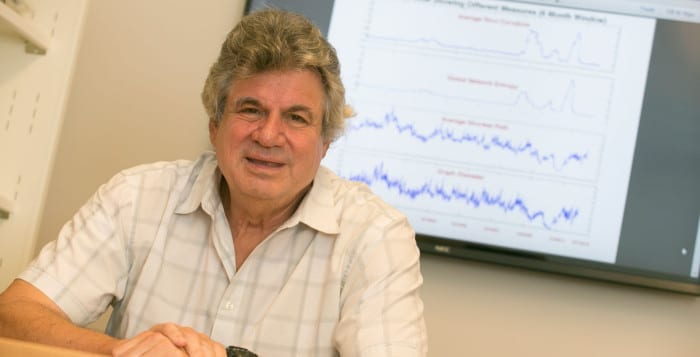Stony Brook’s Tannenbaum uses math to tackle cancer
It’s a dangerous enemy that often turns deadly. Worse than its potentially lethal nature, however, cancer has an ability to work around any roadblocks scientists and doctors put in its path, rendering some solutions that bring hope ineffective.
Researchers around the world are eagerly searching for ways to stay one, two or three moves ahead of cancer, anticipating how the many forms of this disease take medicine’s best shot and then go back to the business of jeopardizing human health.
Allen Tannenbaum, a professor of computer science and applied mathematics and statistics at Stony Brook University, has added a field called graph theory to some of the tools he knows well from his work in medical imaging and computer vision.
A normal, healthy cell is like a factory, with genes sending signals through proteins, enzymes and catalysts, moving reactions forward or stopping them, and the genetic machinery indicating when and how hard the parts should work.
Cancer, however, is like a hostile takeover of that factory, producing the factory equivalent of M16s that damage the cell and the individual instead of baby toys, Tannebaum suggested.
By analyzing how proteins or transcription networks interact, Tannenbaum and his colleagues can develop a model for the so-called curvature of interactions.
Looking at the interactions among parts of the genetic factory, Tannenbaum can determine and quantify the parts of the cell that are following cancer commands, rather than doing their original task.
Curvature isn’t so much a bending of a physical space as it is a change in the way the different proteins or transcription factors function in the discrete networks Tannenbaum uses in cancer and biology.
“The parts are not doing their job the same way,” Tannenbaum said. “We can look and see graphically how different things compare.” He and his collaborators recently published their findings in the journal Scientific Reports.
Using mathematical formulas to define a range of interactions, Tannenbaum can determine how quickly a cancer or normal cell can return to its original state after a disturbance. This ability is called its robustness.
The study “brings to light a new way to understand and quantify the ability of cancer cells to adapt and develop resistance,” explained Tryphon T. Georgiou, a professor in the Department of Electrical and Computer Engineering at the University of Minnesota, who has known Tannenbaum for over 30 years and collaborated on this study. “It also provides ways to identify potential targets for
drug development.”
Tannenbaum studied cells from six different tumor types and supplemented the study with networks that contain about 500 cancer-related genes from the Cosmic Cancer Gene Census.
In treatments for cancers, including sarcomas, researchers and doctors sometimes try to pull the plug on cancer’s energy network. This method can slow cancer down, but cancer often resumes its harmful operations.
Using models of cancer on a computer, Tannenbaum and the five graduate students and four postdoctoral fellows can run virtual experiments. He can hand off his results to biologists, who can then run tests. Once those scientists collect data, they can offer information back to Tannenbaum.
“This is a team effort,” said Tannenbaum, who works with scientists at Memorial Sloan Kettering, the University of Texas MD Anderson Cancer Center and Brigham and Women’s Hospital.
Georgiou described Tannenbaum as a “brilliant scholar” and a “mathematician with unparalleled creativity,” who has been a “pioneer in many fields,” including computer vision. Indeed, a computer vision program could assist nurses in the intensive care unit on different shifts assess the level of pain from someone who might not otherwise be able to communicate it.
Georgiou called Tannenbaum’s work on cancer a “mission” and said Tannenbaum is “absolutely determined to use his remarkable skills as a mathematician and as a scientist” to defeat it.
Tannenbaum, who recently took his grandchild to a Mets win at CitiField, said coming to Stony Brook in 2013 was a homecoming, bringing him closer to his native Queens. He cited two famous graduates from Far Rockaway High School: the physicist Richard Feynman, who helped develop the atomic bomb, and Bernie Madoff.
He and his wife Rina, who is a professor in materials science and engineering at Stony Brook, live in Long Island City.
Tannenbaum hopes to continue to build on his work applying math to solving cancer.
“There’s a lot of mathematical play left and then testing the predictions in a biological/medical setting,” he said.







